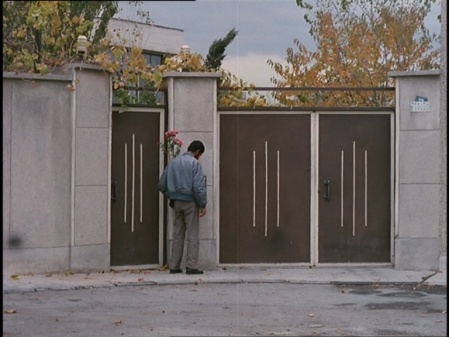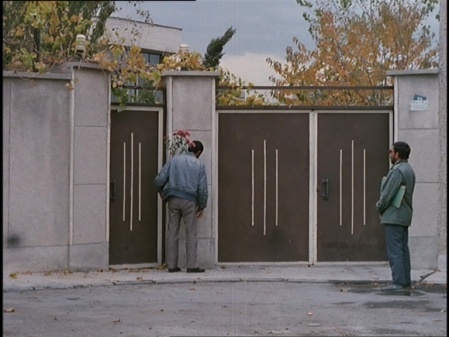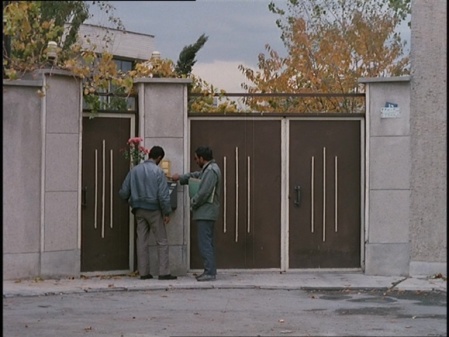Colour Me Kiarostami

(Watching Iranian films is useful for reasons other than the purely cinematic. I think a lot of us don’t really see inhabitants of Muslim countries as being people just like us. When you see the movies, you realise they are.)
This is the ending of CLOSE-UP, more or less. Spoiler alert!
Abbas Kiarostami’s film tells the true story of a poor man who impersonates film director Mohsen Makhmalbaf, working his way into the bosom of a family by claiming he wants to film in their house and cast their grown-up kids in his forthcoming film, HOUSE OF THE SPIDERS. Not a very flattering title. Remarkably, Kiarostami is able to get all the participants in this weird and creepy true-life tale to play themselves. Even the real Makhmalbaf turns up at the end.

The whole time I was watching this, I was wondering if the “Bogus Makhmalbaf” is telling the truth when he says he carried out this fraud as a way of getting vicariously involved in cinema, which he loved, and because it gave him, for the first time in his life, a sense of AUTHORITY. I wondered if he was perhaps attracted to one or other of the young siblings. “Was it the sex thing? Was in the old sex thing, Archie?” asked Arthur Hill in PETULIA. The movie doesn’t challenge the excuses given, but we do have space to make up our own stories.
At the end of the film, Bogus M is released from his short prison sentence, meets the Real M (who toyed with fiction and truth in his own film, A MOMENT OF INNOCENCE), and goes to apologise to the family he conned.

He buzzes the door and says his name. Silence. They do know his real name, but I guess they’re not used to hearing it from him?
So he says, “Makhmalbaf,” to remind them. Silence again. Possibly that wasn’t the right thing to say, if he’s meant to be a reformed character.
Then Real Makhmalbaf steps forward and says “Makhmalbaf” into the intercom and this time the door is opened. He said it with much more AUTHORITY.
Kubrick, of course, also had an impersonator, and this also became the subject of a film, COLOUR ME KUBRICK. To make a round trilogy, we really ought to dig up another story about a celebrity impersonator fixating on an arthouse filmmaker with a K in his name. If no such story exists yet, who can we have impersonated in order to make it true? Best not be Toback.
(Is it OK to begin a blog post with a parenthesis? Oh well, too late now.)
November 20, 2017 at 7:04 pm
(Sure, why not?)
November 20, 2017 at 8:17 pm
How about Kurosawa, imitator played by Sergio Leone?
November 20, 2017 at 8:21 pm
I think a lot of us don’t really see inhabitants of Muslim countries as being people just like us. When you see the movies, you realise they aren’t, actually. They ARE people of course, but they aren’t just like us. There are all kinds of odd differences and assumptions. That’s true of films from every culture – it’s one of the wonderful things about them.
November 20, 2017 at 9:23 pm
I think Leone would struggle to pass as AK irl. Too short.
The cultural differences and the behavioral differences that result, in people of different cultures, are mostly kind of easy to get around once you spend some time, either in reality or in a movie. Big prejudices are a problem. But you can even begin to see how they might arise. And underneath all that, human nature seems pretty consistent.
November 21, 2017 at 3:13 pm
In the most recent NYRB, the estimable Phillip Lopate offers a celebration of Hong Sang-soo’s films and in passing he offers the idea that American distributors won’t market foreign films from directors like Kiarostami and Hou Hsiao-hsien “because of Americans’ resistance to subtitled movies and even to learning the names of non-European foreign auteurs”.
Because he loves Hong’s work, Lopate’s sputtering is understandable. But Hamlet’s ” ’twas caviare to the general” is a fairer articulation of an epicure’s frustration.
December 1, 2017 at 2:18 pm
It’s one of the most beautiful films I’ve seen.
December 1, 2017 at 7:05 pm
It has a beautiful generosity of spirit.